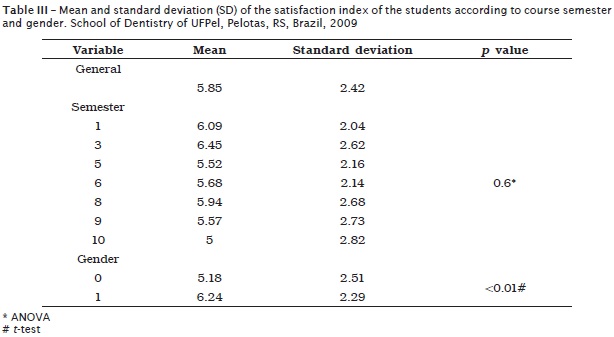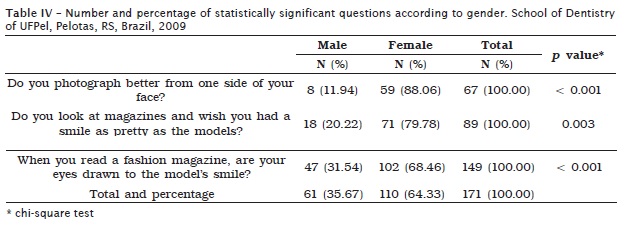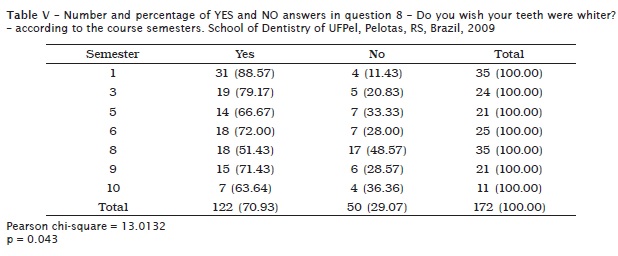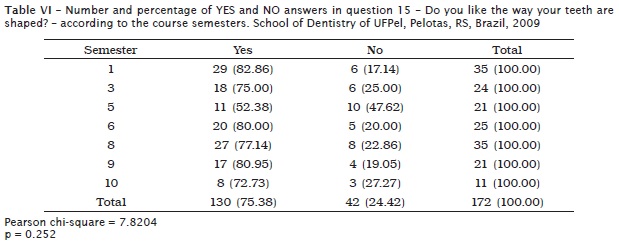Services on Demand
Article
Related links
Share
RSBO (Online)
On-line version ISSN 1984-5685
RSBO (Online) vol.9 n.4 Joinville Oct./Dec. 2012
Original Research Article
Dental esthetic self-perception of Brazilian dental students
Gabrielle de Carli da Silva I ; Eduardo Dickie de Castilhos II ; Alexandre Severo Masotti III ; Sinval Adalberto Rodrigues-Junior IV
II Department of Public Health, School of Dentistry, Federal University of Pelotas – Pelotas – RS – Brazil
III Department of Semiology and Clinics, Federal University of Pelotas – Pelotas – RS – Brazil
IV School of Dentistry, Universidade Comunitária da Região de Chapecó – Chapecó – SC – Brazil
ABSTRACT
Introduction: Esthetics in dentistry aims to improve the patients' self-esteem and satisfaction regarding how beautiful and attractive they feel. However, patients and dental professionals may perceive the concept of esthetics differently instead, which may cause the dissatisfaction of the patient with the results of the treatment. Objective: This cross-sectional observational study aimed to verify the esthetic self-perception of undergraduate dental students regarding their own smile. Material and methods: A questionnaire, designed by Goldstein 10 to measure the patients' self-perception and satisfaction, regarding their smiles, was applied to undergraduate students of different semesters of the School of Dentistry of the Federal University of Pelotas. Results: Our results showed that women are more dissatisfied with their smiles than men. Students attending different semesters worried somehow about the esthetics of their smiles and revealed the wish of having whiter teeth. Most students are satisfied with the shape of their teeth. Ninety two percent of the students feel self-confident regarding to smile, 90% believe someone else has a better smile, 87% look at the smile of models in fashion magazines, 71% wish to have whiter teeth and 80% wish to have rather a bigger or smaller teeth. Conclusion: Undergraduate dental students have a positive self-perception of their smile. Women are less satisfied than men. Students of the earlier semesters wish to have whiter teeth than students from the later semesters.
Keywords: dental esthetics; operative dentistry; mouth.
Introduction
The concept of beauty exists since the beginning of the human kind. Ancient Greeks believed beauty was of supernatural origin. In fact, nobody took beauty as seriously as the Greeks, who admired the nature and wondered whether they were capable of reproducing what the gods had created. Catholic theologists during the middle age, on the other hand, presented an ambivalent attitude towards beauty; they would fear and believe it as the demon's temptation and vanity work and would, at the same time, consider it as a sign of God's blessing. During the Renascence, however, the concept of beauty would again resemble the one of the Greek ideal and it was extensively expressed through paintings and sculptures 15.
The concept of esthetics as a science is strongly related to the concept of beauty, and contains a highly subjective component. Although different, esthetics and beauty complement each other. According to Chain et al. 3, beauty exists as an end in itself, pleasing by the form. However, it does not depend on the sensitive attraction and on the concept of utility or perfection. Beauty also depends on the cultural and historical period in which it is being analyzed, as it determines what is pleasant to be admired at a certain moment or place 6.
Esthetics in dentistry aims to create beauty and attraction, to elevate the self-esteem and to make patients satisfied with an important, expressive and socially valued part of their bodies. Most patients go to dental offices nowadays looking for an esthetically pleasant smile, being stimulated by the esthetic patterns suggested by the society and the media, which associate a beautiful smile to success. This became so important that being out of this social pattern may produce negative psychosocial effects, generating lack of social interaction and introversion 4.
Van der Geld et al. 21 reminds us that the mouth is the center of the communication in the face, calling the attention of the interlocutor. Studies have analyzed the influence of the oral health of youngsters on the perceived quality of life, and have identified a significant impact of the dental esthetics on this outcome 7,13. Klages et al. 13 observed that minor irregularities in dental esthetics might impact oral health-related quality of life of university students, with ref lexes on social appearance concern, appearance disapproval and dentally-related self-confidence. According to the authors, the satisfaction degree towards the esthetics of the mouth is also related to the selfconsciousness of the individuals 13.
The esthetic dentistry would act on the establishment of an esthetically pleasant smile, with positive and attractive characteristics. For that goal to be successfully achieved, the dentist must recognize the esthetic issues of the dental treatment and determine the treatment plan based on them. Also, he must have in mind that possible differences in esthetic perception between him and the patient may exist and that it would create problems during the treatment if not properly recognized and dealt with 22. A previous study identified significant differences in color perception among parents, dentists and children, revealing different expectations regarding the esthetic component of the treatment 18.
In another study, the patients revealed higher esthetic expectations than the dentists 19. According to the same study, some patients demand extensive esthetic corrections, in an attempt to fulfill expectations that will hardly be reached, such as of white, aligned and perfect teeth. Dentists, on the other hand, are usually concerned with the shape and function of the teeth. The knowledge on how basic esthetic concepts in dentistry are developed amongst dental students may help understanding their own esthetic perception and improve the communication between the dentist and the patient during the planning and implementation of the treatment. Based on that, this study aimed to describe the esthetic perception of dental students about their own smiles at the School of Dentistry of the Federal University of Pelotas, Brazil.
Material and methods
The study was designed as a cross-sectional observational study and it was developed only after its acceptance by the institutional Research Ethics Committee (protocol no. 103/2009). The research subjects were selected by convenience in the different semesters of the dental course (first, third, fifth, sixth, eighth, ninth and tenth) at the School of Dentistry of the Federal University of Pelotas, after being told about the aims of the study and signing a clarified and informed consent form.
A dental esthetics self-perception questionnaire, originally designed by Goldstein 10, was applied to the subjects in a single opportunity. The questionnaire contained 15 YES or NO questions that inquired about: confidence when smiling, whether the subject put the hand over the mouth when he/she smiles, whether he/she believes someone else has a better smile, whether the subject looks at magazines and wishes he/she had a smile as pretty as the models, whether he/she notices any defects in his/her gums or teeth, whether he/she wishes his/her teeth were whiter, whether he/she is satisfied with the size and shape of his/her teeth and gums.
A score was set based on the 15 questions. Questions 1, 9 and 15 were considered negative questions, and scored when the answer was NO. The remaining questions were scored when the answer was YES. The score varied from 0 to 15, being 0 a totally positive and 15 a totally negative esthetic self-perception.
Data were stored in Microsoft Office Excel 2007 (Microsoft Corporation, WA, USA) and transferred to Epi Data 3.1 (EpiData Association) for analysis. Variables were grouped into three categories: gender, age and course semester. Chisquare, analysis of variance and t-test were applied to the data (α = 0.05).
Results
Approximately 42% of the regular students (n = 172) answered the quest ionnaire. The percentage of participation within the selected semesters was of 64%. The eighth semester presented the highest number of participants (83%), while the tenth presented the lowest (31%).

The mean age of the participants was of 23 years, ranging from 17 years to 57 years.
Table II depicts the frequency of answers for each question of the questionnaire. 92% of the subjects feel confident when smiling in front of other people. Conversely, 90% believe someone else has a better smile, 44% have already hidden the smile with the hands, 52% wish to have a smile as beautiful as the models in magazines, 73% notice defects in gums and teeth, 71% wish their teeth were whiter and 42% dislike the shape of their teeth.

The average index of satisfaction was of 5.85. In the 1st and 3rd semesters, the mean indexes of satisfaction were of 6.1 and 6.4, respectively, while in the 10th semester, the index was of 5. There were no statistically significant differences of esthetic perception in the different course semesters (p = 0.6). On the other hand, significant differences were observed concerning gender, with women revealing themselves more dissatisfied with their smiles than men. Table IV shows the questions that presented answers statistically different for both genders.


The wish of having whiter teeth (question 8) was more prevalent in the initial semesters, diminishing in the later ones (table V). When asked about whether they liked the way their teeth were shaped (question 15), 70% of the students answered YES.


Discussion
Percept ion and at t itudes regarding the appearance of the smile vary from one individual to another and they are influenced by factors that affect the individuals in a different way, depending on their age, gender, marital status, socioeconomic status, level of education, occupation, influence of family, peers, colleagues, cultural aspects and the mass media 12,20. Therefore, attempts to screen the esthetic self-perception of a given population are a challenge, as well as the comparison of results, which seldom present similarities.
Our results revealed that most students (92%) feel comfortable with their smiles; conversely, 90% think someone else has a better smile. In general, individuals enroll Brazilian dental schools very young (around 17-20 years old) and, in recent days, youth is highly influenced by the media and other external references 21. They are also in an important moment for the definition of their personality and the attractiveness of their smile plays a key psychosocial role in the process 21. A recent study revealed that most Brazilian teenagers that seek for orthodontic treatment do so as a means of improving the dentofacial esthetics and they also believe that the treatment could improve their quality of life 14.
The satisfaction index used in our study varied from 0 to 15, the first indicating a totally positive and the last a totally negative self-perception of the smile. The mean satisfaction index found was 5.85, characterizing a generally positive perception of the smile amongst dental students (table III).
Women revealed themselves more dissatisfied with their smiles than men, reinforcing a tendency that demonstrates that women are more aware, sensitive and exigent about their appearance 8,18,20. Also, women have been shown as more concerned with the esthetical implications of missing teeth 9 and with scars resulting from physical injuries 1,20.
In our study, the gender was significant for three questions (table IV). Women, more than men, looked at the smiles of models in fashion magazines, wished to have a smile as beautiful as the models and believed they photographed better from one side of the face. This behavior also confirms the increased self-awareness of women when it comes to beauty comparing to men, and it might be explained by the fact that women keep in touch with fashion issues more than men.
The wish of having whiter teeth was manifested in all the semesters for most students. With exception of the eighth semester, the wish of whitening the teeth overcame 60% of the students (table V), which reinforces the observation that there has been an increase in the demand for tooth whitening as a smile improving option 17,19.
In our study, the preference for whiter teeth was considerably higher in the first semesters of the dental course. Previous reports have shown that lay people are usually more demanding with the esthetics of the smile when compared to dental professionals 18,19. Taking into consideration that dental students from the first semesters are more likely laypeople than dental professionals, they could change the way they understand and perceive dental esthetics as they go through the dental course.
Also, one could speculate that the understanding of the color characteristics of dental structures, the physiological process of color change and the 'natural' tooth color by the dental students might reduce the demand for tooth whitening. Most likely, the process of becoming a dentist makes dental students more aware of the appearance of the natural teeth, including the color. In a previous study, Carlsson et al. 2 observed a stronger preference for whiter teeth by non-dentists than by dentists. Besides, younger subjects prefer white teeth better than older ones 11 and, even though the age difference between students from the first semesters and later semesters is not so high, it is possible that it influenced their preferences.
The cultural phenomenon of tooth whitening has already reached several countries. In US, 34% of the adult population is not satisfied with the color of their teeth 16. In fact, the current culture dictates not only the demand for a healthy mouth, but also a perfect smile 11. Since Brazilians are highly aware and demanding regarding esthetic issues related to their bodies, an increase in the demand for whiter teeth in Brazil is very likely to be happening 5.
As opposed to what was observed concerning tooth color, most dental students (76%) considered the shape of their teeth satisfactory (table VI). Though tooth shape and alignment are considered important as esthetic variables, Samorodnitzky- Naveh and Geiger 17 observed that they are not as important as the tooth color. Also, one should consider our results cautiously, since most students had been submitted to orthodontic treatment prior to their enrollment in the dental course, which may collaborate to the high percentage of satisfaction in this field.
Complementary studies should be conducted in this area having in mind the needs and difficulties professionals face when planning an esthetic treatment: (1) the objective variables that interfere in the beauty and attractiveness of the smile, such as the size, shape and proportion of the teeth, the buccal corridor, curvature of the lips, the gingival shape and contour, should be studied and compared to the self-perception of the subjects about their own smile; (2) the self-perception of the smiles of the subjects ought to be screened in multicentric studies, taking into consideration the local, cultural and socio-economic aspects involved.
Conclusion
A positive esthetic self-perception was observed in dental students when it comes to their smile. Women revealed themselves less satisfied with their smile than men. The students' wish for whiter teeth differed between the semesters of the course, being higher in earlier semesters.
References
1. Akarslan ZZ, Sadik B, Erten H, Karabulut E. Dental esthetic satisfaction, received and desired dental treatments for improvement of esthetics. Indian J Dent Res. 2009;20(2):195-200. [ Links ]
2. Carlsson GE, Wagner IV, Odman P, Ekstrand K, MacEntee M, Marinello C et al. An international comparative multicenter study of assessment of dental appearance using computer-aided image manipulation. Int J Prosthodont. 1998 May- Jun;11(3):246-54.
3. Chain MC, Rodrigues CC, Andriani O. Estética: dominando os desejos e controlando expectativas. In: Cardoso RJA, Gonçalves EAN. Estética. São Paulo: Artes Médicas; 2002. p. 43-52.
4. Coffield KD, Phillips C, Brady M, Roberts MV, Strauss RP, Wright JT. The psychosocial impact of developmental dental defects in people with hereditary amelogenesis imperfecta. J Am Dent Assoc. 2005 May;136(5):620-30.
5. Demarco FF, Meireles SS, Masotti AS. Over-thecounter whitening agents: a concise review. Braz Oral Res. 2009;23(Spec Iss 1):64-70.
6. Eco U. História da beleza. Rio de Janeiro: Record; 2004. 438 p.
7. Ferreira MC, Goursand D, Bendo CB, Ramos- Jorge ML, Pordeus MI, Paiva SM. Agreement between adolescents' and their mothers' reports of oral health-related quality of life. Braz Oral Res. 2012 Mar-Apr;26(2):112-8.
8. Flores-Mir C, Silva E, Barriga MI, Lagravere MO, Major PW. Lay person's perception of smile aesthetics in dental and facial views. J Orthod. 2004 Sep;31(3):204-9.
9. Gerritsen AE, Sarita P, Witter DJ, Kreulen CM, Mulder J, Creugers NH. Esthetic perception of missing teeth among a group of Tanzanian adults. Int J Prosthodont. 2008 Mar-Apr;21(2):169-73.
10. Goldstein ER. Change your smile. 3. ed. Chicago: Quintessence Books; 1997. 324 p.
11. Joiner A. Tooth colour: a review of the literature. J Dent. 2004;32:3-12.
12. Jornung J, Fardal O. Percept ions of patients' smiles: a comparison of patients' and dentists' opinions. J Am Dent Assoc. 2007 Dec;138(12):1544-53.
13. Klages U, Bruckner A, Zentner A. Dental aesthetics, self-awareness, and oral-related quality of life in young adults. Eur J Orthodont. 2004 Oct;26(5):507-14.
14. Marques LS, Pordeus IA, Ramos-Jorge ML, Filogônio CA, Filogônio CB, Pereira LJ et al. Factors associated with the desire for orthodontic treatment among Brazilian adolescents and their parents. BMC Oral Health. 2009;9:34.
15. Mondelli J. Estética e cosmética em clínica integrada restauradora. 2. ed. São Paulo: Quintessence; 2003. 546 p.
16. Odioso LL, Gibb RD, Gerlach RW. Impact of demographic, behavioural, and dental care utilization parameters on tooth color and personal satisfaction. Compend Contin Educ Dent. 2000 Jun;29:S35-S41.
17. Samorodnitzky-Naveh GR, Geiger SB. Patients' satisfaction with dental esthetics. J Am Dent Assoc. 2007 Jun;138(6):805-8.
18. Shulman JD, Maupomé G, Clark DC, Levy SM. Perceptions of desirable tooth color among parents, dentists and children. J Am Dent Assoc. 2004 May;135(5):595-604.
19. Tortopidis D, Hatzikyriakos A, Kokoti M, Menexes G, Tsiggos N. Evaluation of the relationship between subjects' perception and professional assessment of esthetic treatment needs. J Esthet Restor Dent. 2007 Jun;19(3):154-63.
20. Vallittu PK, Vallittu ASJ, Lassila VP. Dental aesthetics – a survey of attitudes in different groups of patients. J Dent. 1996 Sep;24(5):335-8.
21. Van der Geld P, Oosterveld P, Van Heck G, Kuijpers-Jagtman MA. Smile attractiveness. Angle Orthod. 2007;77(5):759-65.
22. Ward DH. A study of dentists' preferred maxillary anterior tooth width proportions: comparing the recurring esthetic dental proportion to other mathematical and naturally occurring proportions. J Esthet Restor Dent. 2007 Dec;19(6):324-37.
 Correspondence:
Correspondence:
Sinval Adalberto Rodrigues-Junior
Universidade Comunitária da Região de Chapecó
Área de Ciências da Saúde – Caixa postal 1141
Av. Senador Atílio Fontana, n. 591-E – Efapi
CEP 89809-000 – Chapecó – SC – Brasil
E-mail: rodriguesjunior.sa@unochapeco.edu.br













